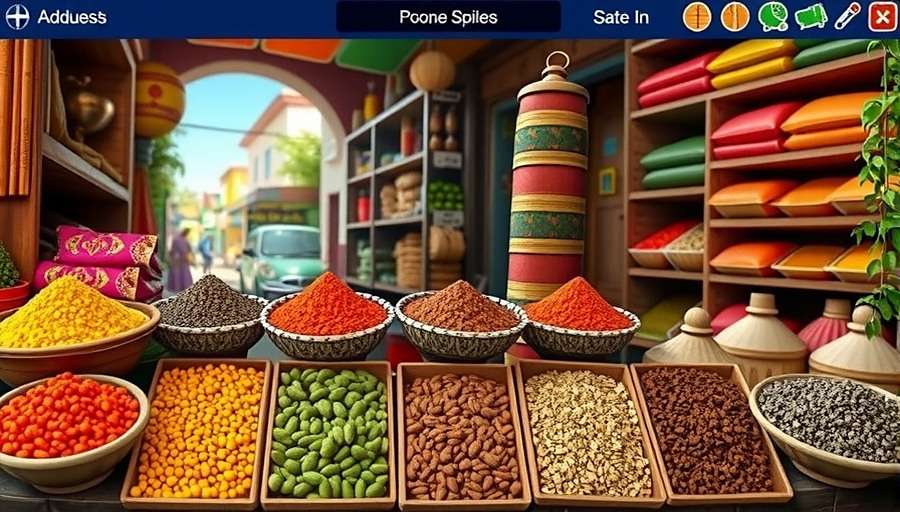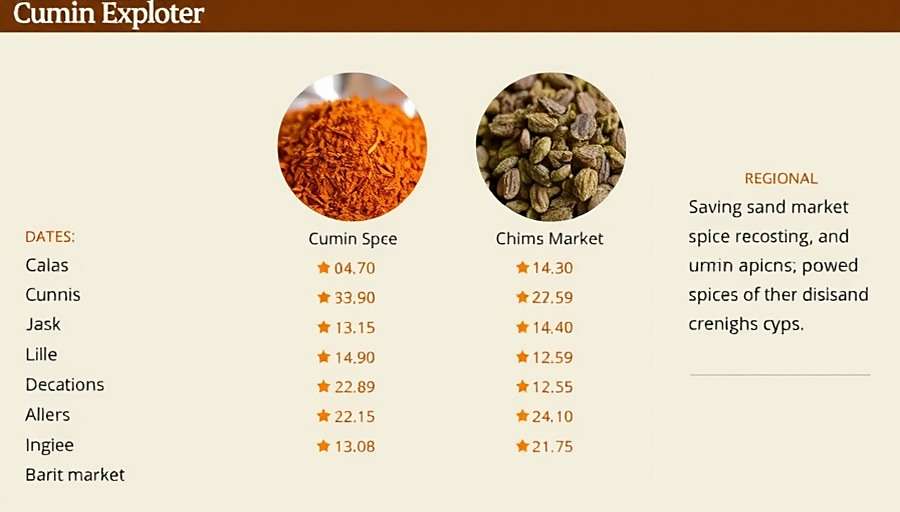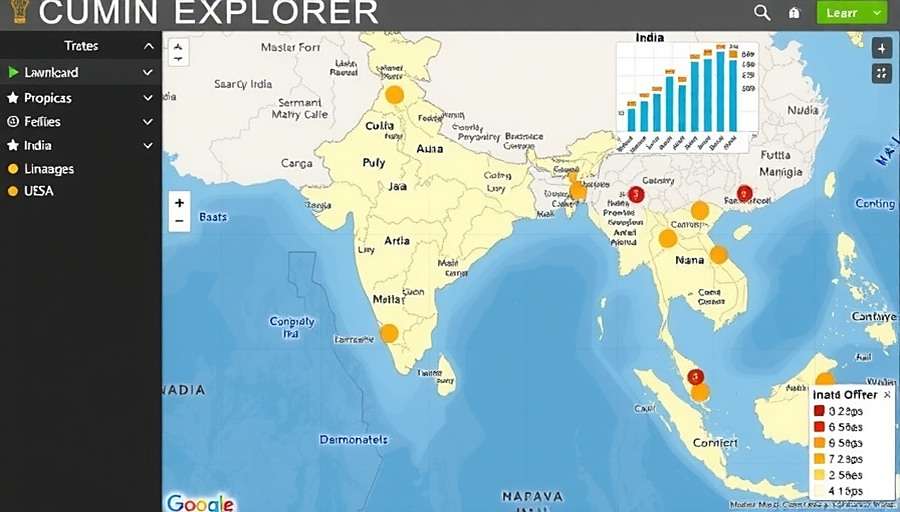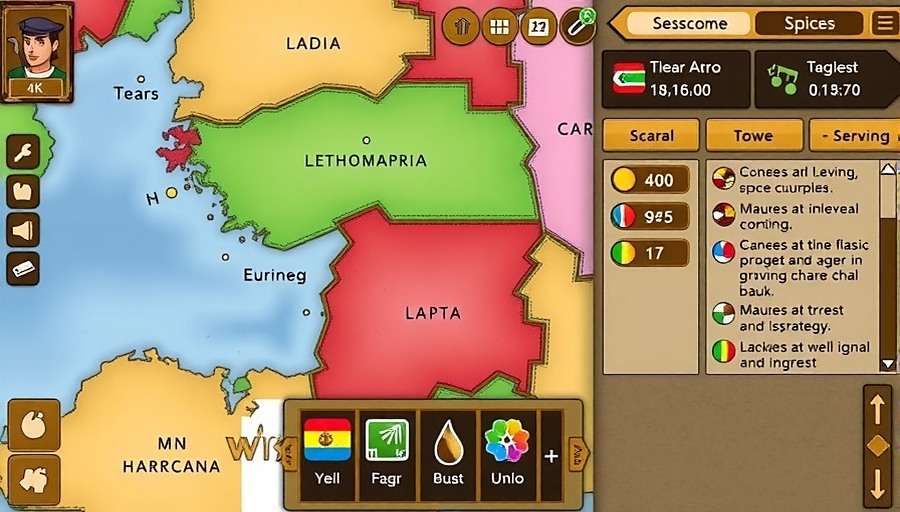Cumin Explorer: India's Ultimate Spice Adventure Game

Introduction to Cumin Explorer
Cumin Explorer is not just a game; it's a journey through India's rich culinary heritage, wrapped in an engaging mobile gaming experience. Launched in 2022 by Daman Games, this innovative title has taken the Indian gaming market by storm, captivating players with its unique blend of education and entertainment.
Unlike any other game in the Indian mobile gaming landscape, Cumin Explorer invites players to step into the role of a young spice merchant traveling across India, discovering regional spices, mastering traditional preparation techniques, and building a spice empire that spans from the snowy Himalayas to the sunny shores of Kerala.
What truly sets Cumin Explorer apart is its deep respect for Indian culture and culinary traditions. The game developers worked closely with regional chefs, culinary historians, and local experts from across India to ensure authentic representation of each region's unique spice heritage.
From the fiery chilies of Andhra Pradesh to the aromatic cardamom of Kerala, from the pungent asafoetida of Bihar to the fragrant saffron of Jammu & Kashmir, every spice in Cumin Explorer is presented with historical context and cultural significance, making the game as educational as it is entertaining.
📊 Key Statistics of Cumin Explorer
The game's popularity cuts across all age groups and demographics, with a significant player base among both urban and rural users. Housewives enjoy recognizing familiar spices and techniques from their own kitchens, while younger players discover the cultural stories behind the spices they see daily in their homes.
School children often use Cumin Explorer as an educational tool to learn about India's geographical diversity and culinary traditions, making it a favorite among parents who appreciate its educational value alongside its entertainment quotient.
One of the most remarkable achievements of Cumin Explorer is how it has fostered cross-cultural understanding within India itself. Players from North India are discovering the unique spices of the Northeast, while South Indian players are learning about the Mughal-influenced spice blends of Uttar Pradesh and Delhi.
This cross-pollination of culinary knowledge through gameplay has created unexpected conversations and appreciation for India's incredible diversity, making Cumin Explorer much more than just a game—it's a cultural bridge.
Gameplay Mechanics of Cumin Explorer

The gameplay of Cumin Explorer is a clever blend of adventure, strategy, and educational elements, designed to be accessible to casual players while offering depth for more dedicated gamers. The core loop involves three main activities: exploration, collection, and trading.
Players start their journey in a small village in their chosen region, equipped with basic knowledge and a simple spice collection kit. As they progress, they unlock new regions, each with its unique spices, challenges, and cultural elements to discover.
Exploration and Discovery
Exploration in Cumin Explorer takes players through beautifully rendered environments representing different parts of India. From the bustling spice markets of Old Delhi to the backwaters of Kerala, each location is meticulously designed to reflect its real-world counterpart.
During exploration, players encounter various non-playable characters (NPCs) who provide quests, share local knowledge, and offer opportunities to learn about regional spices. These NPCs speak in regional dialects (based on the game's language setting) and share authentic stories and folklore related to spices.
For example, in the Kashmiri region, a local elder might teach players about the labor-intensive process of harvesting saffron, while in Karnataka, a Udupi chef could explain the importance of jaggery in balancing spice flavors.
Spice Collection and Processing
Collecting spices in Cumin Explorer involves various mini-games that simulate real-world harvesting and processing techniques. These mini-games vary depending on the spice and region:
- For cardamom in Kerala, players carefully pick pods from plants without damaging them
- For turmeric in Andhra Pradesh, players participate in cleaning and drying activities
- For cumin in Rajasthan, players winnow and sort seeds to remove impurities
- For red chilies in Nagaland, players string and dry the peppers in the sun
Each mini-game requires different skills—some test timing and reflexes, others require precision and patience. Successfully completing these activities yields higher quality spices, which fetch better prices in the market and are more valuable for completing specific quests.
Trading and Market Dynamics
Trading forms the strategic core of Cumin Explorer. Each region has its own market where certain spices are in high demand while others are abundant and cheap. Players must learn these market dynamics to maximize their profits.
The market prices fluctuate based on in-game events, seasonal changes, and player actions across the game's server. For example, during the monsoon season in the game, prices for dried spices tend to rise, while fresh spices become more expensive during winter months.
Players can establish trade routes between regions, invest in storage facilities to hold spices for better prices, and even negotiate special deals with regular customers. Building a reputation as a reliable trader unlocks special opportunities and access to rare spices.
Progression and Customization
As players progress in Cumin Explorer, they earn "Spice Mastery Points" which can be used to unlock new skills and abilities. These include:
- Better detection of rare spices during exploration
- Improved processing techniques for higher quality outputs
- Enhanced bargaining skills for better trade deals
- Special knowledge of medicinal properties of certain spices
Players can also customize their avatar with region-specific clothing and accessories collected during their journey. From a traditional dhoti-kurta in Punjab to a colorful lungi in Tamil Nadu, these customizations allow players to express their journey through India's diverse cultural landscape.
Another unique feature is the "Spice Journal" that automatically records every spice discovered, complete with its botanical information, culinary uses, regional significance, and even traditional medicinal applications. This journal has become a valuable reference tool for many players, blurring the line between gaming and education.
Regional and Localized Versions of Cumin Explorer
One of the most impressive aspects of Cumin Explorer is its commitment to authentic regional representation. Rather than simply translating the game into different languages, the developers have created truly localized experiences that reflect each region's unique spice culture and culinary traditions.
This approach has been instrumental in the game's widespread appeal across India's diverse linguistic and cultural landscape.

Language Localization
Cumin Explorer is available in 15 languages, covering all major linguistic groups in India: Hindi, Bengali, Telugu, Marathi, Tamil, Urdu, Gujarati, Kannada, Malayalam, Odia, Punjabi, Assamese, Maithili, Kashmiri, and English.
What sets the localization apart is the attention to regional dialects and culinary terminology. For example, the Punjabi version uses distinct terms for spice preparation that differ from those used in the Hindi version, while the Tamil version includes vocabulary specific to Chettinad cuisine.
Voice actors for each language version are native speakers, ensuring authentic pronunciation and intonation. This linguistic attention to detail has been widely praised by players who appreciate hearing their local dialects represented accurately in a mobile game.
Regional Content Differences
Beyond language, each regional version of Cumin Explorer includes unique content tailored to local traditions:
Features more emphasis on Mughal-influenced spice blends, with special quests involving biryani preparation and kebab seasoning. The Punjabi version includes special levels focused on tandoori spices and pickling techniques.
Highlights the distinctive spice profiles of each state, with the Tamil version featuring Chettinad masala challenges, the Kerala version focusing on curry leaf and coconut combinations, and the Andhra version emphasizing chili varieties and pickling.
Includes unique content on mustard-based pastes, panch phoron blends, and the distinctive use of poppy seeds in Bengali cuisine. The Odia version features special levels on panchamrita and temple food preparations.
Focuses on the unique spice combinations of Gujarati thalis, Maharashtrian goda masala, and Goan vindaloo preparations. The Rajasthani content emphasizes desert-adapted spice preservation techniques.
Introduces players to lesser-known spices like bhut jolokia, Sichuan pepper, and regional herbs. Special attention is given to the unique fermented preparations and bamboo-cooked dishes of the region.
Cultural Nuances and Sensitivity
The developers of Cumin Explorer worked with regional consultants to ensure cultural sensitivity and accuracy. For example, during Ramadan, the game features special non-alcoholic, halal-compliant spice recipes in Muslim-majority regions.
During Hindu festivals, appropriate vegetarian-only vegan spice preparations are highlighted, while regional festivals like Pongal, Bihu, and Onam each have special in-game events that reflect their unique culinary traditions.
This level of cultural respect has not only avoided controversies but has earned the game praise from cultural organizations and community leaders who appreciate seeing their traditions represented with accuracy and respect.
Many players have reported that Cumin Explorer has helped them discover aspects of their own regional culture they were previously unaware of, making the game a tool for cultural preservation and education within communities.
Downloads and Availability of Cumin Explorer
Since its launch in July 2022, Cumin Explorer has achieved remarkable download numbers, crossing the 75 million mark in India alone by March 2023. This makes it one of the fastest-growing homegrown mobile games in recent years, with a particularly strong following in Tier 2 and Tier 3 cities.
The game's accessibility across different devices and network conditions has contributed significantly to its widespread adoption, with special optimizations for low-bandwidth areas and entry-level smartphones that are popular in rural India.
Platform Availability
Cumin Explorer is available on all major mobile platforms with regional optimizations:
- Android: Available on Google Play Store with multiple APK options (45MB basic version, 95MB HD version)
- iOS: Available on Apple App Store with a download size of approximately 120MB
- Feature Phones: A simplified Java version is available for popular KaiOS devices
The game is designed to work efficiently even on 2G networks, with an "Offline Mode" that allows players to continue their spice collection activities without an internet connection, syncing progress once connectivity is restored.
Regional Adoption Rates
While Cumin Explorer has found enthusiastic players across India, certain regions have shown particularly high adoption rates:
- Maharashtra: 18% of total downloads, with Mumbai and Pune as key markets
- Uttar Pradesh: 15% of total downloads, showing strong penetration in both urban and rural areas
- Tamil Nadu: 14% of total downloads, driven by the highly localized Tamil version
- Karnataka: 12% of total downloads, with Bengaluru contributing significantly
- West Bengal: 10% of total downloads, with strong engagement in Kolkata and surrounding districts

Monetization Model
Cumin Explorer follows a freemium model, offering full gameplay access without mandatory purchases while providing optional in-app items. This approach has proven particularly effective in the Indian market, where players are hesitant to pay upfront for mobile games.
In-app purchase options range from ₹10 to ₹5,000 and include:
- Spice collection tools that improve efficiency
- Storage upgrades for holding more spices
- Regional outfit packs for avatar customization
- Special market insights that predict price fluctuations
- Limited-edition festival-themed content
Importantly, the game is designed to be fully enjoyable without any purchases, with regular rewards and challenges that allow dedicated players to acquire premium items through gameplay. This fairness has been widely praised in player reviews and has contributed to the game's positive reputation.
The developers have also introduced a "Spice Farmer Subscription" at ₹99 per month, which provides daily rewards and exclusive access to regional events. This subscription model has seen significant adoption among dedicated players, particularly in urban areas.
Player Reviews and Reception of Cumin Explorer
Cumin Explorer has received exceptional reviews from players across India, with an average rating of 4.8 out of 5 across all platforms. This high rating is particularly impressive given the game's large number of reviews—over 2 million as of April 2023.
Players consistently praise the game's educational value, cultural authenticity, and engaging gameplay. Many have commented on how the game has enhanced their appreciation for India's diverse culinary traditions and introduced them to spices and techniques from regions they've never visited.
"I've been playing Cumin Explorer for 6 months now, and it's amazing how much I've learned about Indian spices! As a Gujarati, I thought I knew all about our masalas, but the game taught me so much about North East Indian spices that I'd never even heard of. My mother was surprised when I asked her to make a Bodo-style pork dish using ingredients I discovered in the game!"
"The Tamil version of Cumin Explorer is beautifully done with authentic Chettinad terminology that even my grandmother approves of! I love how the game shows the proper way to roast spices before grinding—something I never paid attention to before. Now I use these techniques in my own cooking. The graphics of Tamil Nadu villages are so accurate it feels like I'm visiting my ancestral home!"
"Cumin Explorer does an excellent job representing Awadhi cuisine and our unique spice blends. The Ramadan special events are particularly well done, with accurate representations of our iftar traditions. My only suggestion would be more content about Mughal-era spice trading, which has such a rich history in Uttar Pradesh. Overall, a fantastic educational game that my whole family enjoys."
"As a food blogger, I'm impressed by the accuracy of Cumin Explorer! The Rajasthani section perfectly captures our unique spice preservation techniques for desert climates. I've actually incorporated several spice combinations I discovered in the game into my recipes. The regional events are brilliant—my daughter and I compete to collect all the special festival spices during Diwali and Holi."
"It's wonderful to see Assamese cuisine represented in Cumin Explorer with such authenticity. The bamboo smoking techniques and our unique use of bhut jolokia are accurately portrayed. I appreciate that the developers didn't just focus on North and South India but included proper representation of Northeast spices. It's helped me teach my children about our food heritage in a fun way."
Critical Acclaim
Cumin Explorer has received widespread recognition from both gaming and cultural critics. It was awarded "Best Educational Game" at the 2023 Indian Gaming Awards and received a special mention from the Ministry of Tourism for "promoting India's culinary heritage through digital innovation."
Cultural critics have praised the game for its respectful and accurate representation of regional traditions, with one reviewer noting that "Cumin Explorer achieves what many cultural documentaries fail to do—making regional Indian culinary traditions accessible and engaging to a national audience."
Educational institutions have also taken notice, with several schools in Maharashtra and Karnataka incorporating the game into their social studies curriculum to teach students about India's geographical and cultural diversity through its culinary traditions.
Tech reviewers have commended the game's optimization for low-end devices, noting that it "brings high-quality educational content to segments of the Indian population often ignored by premium mobile games."
Localized Events in Cumin Explorer
One of the key factors behind Cumin Explorer's sustained popularity is its calendar of regional and seasonal events that celebrate India's diverse festivals and culinary traditions. These events not only provide fresh content for players but also deepen the game's connection to Indian culture.
Each event is meticulously researched to ensure cultural accuracy and relevance, often incorporating traditional recipes, historical anecdotes, and regional customs related to spices and food preparation.
National Spice Festival
Coinciding with the beginning of the spring harvest season across India, this flagship event invites players to collect rare spring spices from each region. Participants can trade region-specific spices with players from other parts of India to complete their collections.
The grand prize is a "National Spice Master" title and a special in-game mortar and pestle set adorned with motifs from all Indian states. In 2023, over 8 million players participated, exchanging more than 45 million virtual spices during the event.
Regional Festival Specials
Each month highlights a different regional festival with special spice-related challenges. For example, the Pongal event in January focuses on turmeric and jaggery preparations, while the Bihu event in April features Assamese bamboo-smoked spices.
Players who participate in all regional events throughout the year receive a "Cultural Connoisseur" badge and access to exclusive regional recipes that combine spices from across India's diverse culinary traditions.

Monsoon Spice Preservation
Celebrating traditional monsoon preservation techniques, this event teaches players how different regions preserve spices during the wet season. From Rajasthan's sun-drying methods to Kerala's smoke-curing techniques, players learn and practice time-honored preservation skills.
Successful preservation yields special "Monsoon-Ready" spices that retain their value longer in the game's markets. Players also collect traditional wisdom cards explaining the scientific basis behind these age-old preservation methods.
Spice Route Challenge
This historical event traces the ancient spice trade routes that connected India to the rest of the world. Players follow in the footsteps of ancient traders, from the Malabar Coast to the Silk Road, learning how Indian spices influenced global cuisine.
Special historical NPCs share stories of how cumin, pepper, and cardamom shaped world history. The event has been praised by educators for making history engaging and accessible to young players.
Community Kitchen Events
These unique events allow players to collaborate in preparing virtual community meals for in-game celebrations or charitable causes. Recent events have included preparing spices for flood relief "community kitchens" and creating special Diwali snacks for senior citizens.
For each virtual meal prepared, the developers donate a small amount to real-world food security initiatives in India. To date, these events have raised over ₹25 lakhs for various food-related charities across the country.
What makes Cumin Explorer's events particularly effective is their ability to balance entertainment with education and social engagement. Players often report learning about regional festivals and traditions they were previously unaware of, fostering cross-cultural understanding through gameplay.
The events also create a strong sense of community among players, with regional forums lighting up with discussions about optimal strategies, traditional recipes, and real-world cultural practices related to each event's theme.
Community and Social Features of Cumin Explorer
Beyond its engaging gameplay and cultural content, Cumin Explorer has fostered a vibrant community of players across India who share a passion for spices, cooking, and cultural exploration. This community has become an integral part of the game's ecosystem, extending its impact beyond the digital realm.
The game's social features are designed to encourage knowledge sharing, collaboration, and friendly competition among players, creating a unique blend of gaming community and culinary enthusiasts' network.

Regional Player Groups
One of the most active aspects of the Cumin Explorer community is its regional player groups, which organize both in-game and real-world activities. These groups go by colorful names that reflect their regional identities:
- "Chettinad Spice Kings" (Tamil Nadu)
- "Punjab Da Mirchi Club" (Punjab)
- "Bengal Masala Masti" (West Bengal)
- "Gujarat Jhinga Jhala" (Gujarat)
- "Assam Bhoot Jolokia Warriors" (Assam)
These groups compete in regional challenges within the game but also collaborate to share real-world recipes and cooking tips. Many organize local meetups where members bring dishes featuring spices highlighted in the game, creating a unique bridge between virtual gameplay and real-world culinary experiences.
The Mumbai chapter's monthly "Spice Swap" events have become particularly popular, where players exchange rare spices from their regions and share preparation techniques they've learned from Cumin Explorer.
Online Forums and Knowledge Sharing
The official Cumin Explorer forums and social media groups have become valuable repositories of culinary knowledge, with players sharing everything from gameplay strategies to authentic regional recipes.
Popular discussion threads include:
- "Real-world equivalents of rare in-game spices"
- "Regional techniques for perfect spice grinding"
- "How Cumin Explorer helped me discover my grandmother's recipes"
- "Festival spice preparations from around India"
- "Spice substitution guides for home cooking"
Notably, these forums have become spaces where younger players ask questions about traditional cooking techniques, and older players share their expertise, creating intergenerational knowledge exchange that might not happen otherwise.
The developers actively curate the best content from these forums, occasionally featuring exceptional player-submitted recipes in special in-game events, further blurring the line between the virtual and real-world culinary experiences.
Content Creation and Streaming
Cumin Explorer has spawned a thriving content creation community, with hundreds of YouTube channels, Instagram accounts, and TikTok profiles dedicated to the game. These creators produce a variety of content:
- Gameplay walkthroughs of difficult spice collection challenges
- Real-world cooking videos using spices and techniques from the game
- Regional spice exploration vlogs visiting actual markets
- Interviews with local chefs about traditional spice usage
- Competitions between players from different regions
The most popular Cumin Explorer content creators have millions of followers, with some even launching their own spice product lines inspired by the game. This vibrant content ecosystem has significantly extended the game's reach and impact beyond its direct player base.
Educational Initiatives
Perhaps most uniquely, the Cumin Explorer community has developed several educational initiatives that leverage the game's content for real-world learning. Teachers have created lesson plans based on the game's spice information, while student groups have organized "Spice Heritage" projects in schools.
In Karnataka, a group of high school students used the game's regional information to create a traveling exhibition on South Indian spices, which has been displayed at several educational institutions. Similarly, a group in Rajasthan developed a mobile app based on the game that helps local farmers identify and price their spice crops more effectively.
These initiatives demonstrate how Cumin Explorer has transcended its role as a mere game to become a platform for cultural preservation and education, with its community actively driving these positive real-world impacts.
Indian Player Strategies for Cumin Explorer
Indian players have developed sophisticated strategies for mastering Cumin Explorer, drawing on both gaming skills and real-life knowledge of Indian spices and regional culinary traditions. These strategies, honed through millions of hours of collective gameplay, can help new players progress more efficiently and derive greater enjoyment from the game.
What's particularly fascinating about Cumin Explorer strategies is how they often reflect real-world knowledge—players with cooking experience frequently excel at certain aspects of the game, while successful in-game strategies sometimes translate back to improved real-world cooking techniques.

Exploration and Collection Strategies
- Follow the real seasons: Focus on collecting spices in the game during their actual harvest seasons in India. The game's market values often reflect real-world seasonal availability, making this a profitable strategy.
- Regional specialization: Rather than trying to collect every spice, specialize in 2-3 regional spice sets. Mastery bonuses for regional specialization often yield better long-term rewards than scattered collection.
- Time your grinding: Different spices in Cumin Explorer have optimal grinding times, just like in real cooking. Cumin and coriander require longer grinding for maximum flavor release, while delicate spices like saffron should be ground minimally.
- Learn the weather patterns: The game's dynamic weather system affects spice quality. Rainy weather in Kerala improves cardamom quality, while dry conditions in Rajasthan are perfect for collecting cumin. Plan your collection around these patterns.
- Complete NPC relationship quests: Building strong relationships with regional NPCs unlocks better quality spices and special collection techniques. Focus on one region's NPCs at a time to maximize these benefits.
Trading and Market Mastery
- Understand real-world spice economics: The game's market dynamics are based on real-world trade patterns. For example, black pepper from Kerala fetches higher prices in North India, while Kashmiri saffron is highly valued in the South. Use this knowledge to maximize profits.
- Create spice blends for higher profits: Combining complementary spices into traditional blends (like garam masala, sambar powder, or panch phoron) yields significantly higher prices than selling individual spices.
- Follow festival calendars: Prices for specific spices spike during related festivals. Stock up on cardamom before Diwali, turmeric before Pongal, and fennel seeds before Ramadan to maximize trading profits.
- Establish trade routes: Set up regular trading paths between complementary regions (e.g., Gujarat to West Bengal, Punjab to Kerala) to build trading reputation bonuses that increase profit margins over time.
- Monitor political events: The game occasionally features regional political events that affect spice prices. For example, border tensions might increase prices for spices traditionally traded across state lines.
Event Competition Tactics
- Prepare region-specific tools: Each event favors different tools. For North Indian events, invest in brass mortar and pestles; for South Indian events, prioritize stone grinders. These tools significantly improve event performance.
- Form regional teams: Events often have team-based rewards. Joining forces with players from the same region (especially those with local knowledge) dramatically improves your chances of success.
- Study event themes in advance: The game hints at upcoming event themes weeks in advance. Research the traditional spices and techniques for these themes to prepare your strategy.
- Time your play during regional peak hours: Events often have bonus periods aligned with local time zones. Playing during these windows (usually early morning and evening in each region) yields better rewards.
- Preserve event-exclusive spices: Special event spices can often be preserved and used in future events. Create dedicated storage for these rare items to gain an advantage in subsequent competitions.
Long-Term Progression Planning
- Balance exploration and specialization: While early game progress requires exploring many regions, long-term success comes from deep specialization in 2-3 regions where you can achieve mastery bonuses.
- Invest in storage first: Upgrade your storage facilities before purchasing new collection tools. Being able to store spices during price fluctuations is more valuable than collecting slightly more spices.
- Learn cross-region spice combinations: The most valuable recipes in Cumin Explorer combine spices from different regions. Invest time in discovering these profitable combinations.
- Participate in community challenges: Group challenges offer better rewards per hour invested than solo play. Even a small time investment in community activities yields significant long-term benefits.
- Track real-world culinary trends: The game occasionally incorporates real-world food trends. Players who notice these trends early (like the growing popularity of Northeast Indian spices) can profit significantly by focusing on these areas.
Many top players emphasize that the most successful Cumin Explorer strategies combine in-game knowledge with real-world understanding of Indian spices and regional cultures. As one top-ranked player from Hyderabad noted, "The best strategy is to play the game with curiosity—both about the gameplay and about the real spices and traditions behind it. The more you learn about actual Indian culinary practices, the better you'll do in the game."
Future Updates and Developments for Cumin Explorer
The development team behind Cumin Explorer has announced ambitious plans for the game's future, with a roadmap extending through 2024 and beyond. These plans focus on deepening the game's cultural content, expanding its educational features, and introducing innovative gameplay mechanics while maintaining the authentic Indian flavor that has made the game successful.
Based on player feedback and emerging trends in Indian mobile gaming, the developers are prioritizing features that enhance social interaction, cultural education, and cross-regional exploration.
Upcoming Features
Scheduled updates for Cumin Explorer include:
- Multiplayer Spice Markets: Real-time player-to-player markets where users can directly trade spices with each other, rather than through the game's automated system. This will include player-set prices and negotiation mechanics based on regional dialects.
- Home Kitchen Integration: A new feature that allows players to photograph real spices they've prepared at home to unlock special in-game rewards. This blurs the line between virtual gameplay and real-world cooking even further.
- Spice Heritage Mode: A documentary-style educational mode featuring interviews with real spice farmers, traditional chefs, and cultural experts from across India. This mode will be available in all regional languages.
- Regional Restaurant Management: An expansion that allows players to open and manage virtual restaurants in different regions, applying their collected spices and knowledge to create authentic regional dishes and attract virtual customers.
- AR Spice Garden: Augmented reality features that let players grow virtual spice plants in their real-world environment using their device's camera. This educational feature teaches about spice cultivation while providing in-game rewards.

Regional Expansion Plans
While Cumin Explorer already covers major Indian regions, the developers plan to expand into more specific local culinary traditions:
- Special focus on Northeast India's diverse tribal spice traditions
- Deep dive into India's Jewish and Parsi culinary spice traditions
- Expanded content on India's coastal spice trading communities
- Detailed exploration of Himalayan medicinal spices and their uses
- Features on India's urban fusion cuisine and modern spice innovations
Each regional expansion is developed with local consultants to ensure authenticity, often incorporating oral histories and family recipes that might otherwise be lost to time.
Educational Partnerships
The Cumin Explorer team has announced plans to partner with educational institutions and cultural organizations to expand the game's educational impact:
- Curriculum materials for schools that use the game to teach geography, history, and cultural studies
- Collaborations with state tourism boards to promote regional culinary tourism through in-game content
- Partnerships with women's self-help groups to feature traditional spice preparation techniques passed down through generations
- Initiatives to document and preserve endangered regional spice varieties through in-game awareness campaigns
These partnerships reflect the game's evolution from entertainment to a platform for cultural preservation and education, with measurable social impact alongside its commercial success.
International Expansion
While currently focused on the Indian market, the developers have announced plans to introduce Cumin Explorer to international audiences, starting with diaspora communities in North America, Europe, and Southeast Asia.
These international versions will maintain the Indian cultural core while adding features that help non-Indian players understand the context and significance of Indian spices. Special "Cultural Guide" characters will explain unfamiliar concepts and traditions, helping to build cross-cultural appreciation through gaming.
Long-term plans include "Global Spice Routes" expansions that connect Indian spices with their historical trading partners, creating a global culinary exploration experience that starts with India's rich spice heritage.